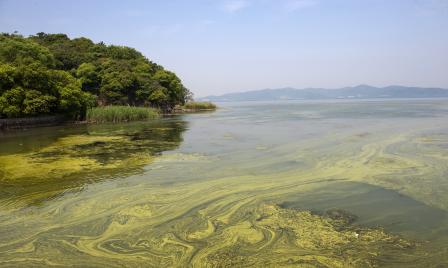Small Systems with a Big Problem: Harmful Algal Blooms
Advice and strategies for drinking water managers.
Published October 27, 2016
 Cyanobacteria shares some properties with algae and are found naturally in lakes, streams, ponds, and other surface waters.As a water manager, there are enough things to worry about year-round when it comes to ensuring the safety of drinking water: meeting safety compliance requirements, taste and odor complaints, and the list goes on. However, every season when the weather and water get warmer, managers must also add harmful algal blooms to their list of concerns.
Cyanobacteria shares some properties with algae and are found naturally in lakes, streams, ponds, and other surface waters.As a water manager, there are enough things to worry about year-round when it comes to ensuring the safety of drinking water: meeting safety compliance requirements, taste and odor complaints, and the list goes on. However, every season when the weather and water get warmer, managers must also add harmful algal blooms to their list of concerns.
Harmful algal blooms (HABs) are overgrowths of photosynthesizing organisms that include algae and cyanobacteria. Not all algae or cyanobacteria are harmful, but certain species of are toxic to people and animals when consumed or touched, which is why HABs pose particular challenges for small drinking water systems. EPA recently held a webinar on preparing drinking water managers to properly treat water affected by HABs. Here are some of the most important takeaways:
The best defense against cyanotoxins is to take full advantage of the existing treatment processes
The best treatments for HABs vary from system to system, depending on a facility’s treatment process and the toxins specific to their source water. HAB toxins are easiest to treat when they are still inside the cyanobacteria cell. According to EPA engineer Nick Dugan, a conventional treatment process (which physically removes particulate matter in the water) should be able to remove intact cyanobacterial cells from water. This process uses coagulation and flocculation to clump and flock the cells together so that they are large enough to be removed during the sedimentation and filtration steps.
If the toxins have been released from the cell into the water, they can be dissolved and harder to remove. Additional treatment for these released toxins may include temporarily stopping certain processes that could promote further toxin release, as well as adding an adsorbent—a material that can accumulate other material on its surface, like powdered activated carbon—to the existing process. Increasing the level of chlorine in the water is also a potential option (depending on what other disinfection by-products are being used in treatment) because chlorine has the ability to remove dissolved toxins.
It’s important to remember that each system and the toxins they are dealing with are different, so managers should inspect each step of the treatment process and assess what’s working well and what could be further optimized.
Pigment and toxin analyses are necessary to make good treatment decisions
There are two factors that indicate a cyanobacteria HAB: phycocyanin, a pigment molecule that indicates the presence of cyanobacteria, and cyanotoxins. To figure out how well a plant’s treatment process controls HABs, water managers can use a two-step process: they can do a pigment analysis to figure out if phycocyanin is present, and then a toxin analysis to determine what kinds (if any) of cyanotoxins are present.
To test for the presence of phycocyanin, managers can use an in vivo analysis method that determines what kinds of pigment molecules are present in a sample based upon the light wavelengths they emit during fluorescence. In vitro analysis also uses fluorescence as an indicator of pigment concentration, but the method requires analysts to extract the pigment molecules from their cells and put them in solvent to determine the pigment concentration level. Both methods can be used separately or in combination to analyze water samples for cyanobacteria.
If water managers discover that they’re dealing with cyanobacteria from the pigment analysis, toxin analysis will help them figure out what toxins are present and at what concentrations. One way to perform a toxin analysis is with enzyme linked immunosorbent assays (ELISAs). In this process, researchers take antibodies specific to each suspected toxin and run tests to determine if toxin molecules present in the sample match up with the antibody. If and when an antibody and a toxin molecule match up, there will be a chemical reaction and a visible color change for the researcher to see after an enzyme has been added.
There are other methods, but the bottom line is that toxin and pigment analysis are great strategies to help water managers to determine if HABs are in their water.
Small systems should maintain source water monitoring programs to stay ahead of HABs.
In the case of HABs, being prepared ahead of a bloom is the best strategy because blooms can spread very quickly. That’s why it’s important that water managers constantly monitor their water, both at the source and in the treatment plant, for any indication that a bloom might be occurring. One way to do this is to use the pigment analysis discussed above.
Harmful algal blooms have the potential to be a big problem for small systems. However, armed with the right knowledge, systems managers can take steps to identify and treat HABs to ensure the safety of our finished drinking water.
Need more small systems info? To hear the entire webinar on harmful algal blooms or to sign up for future small systems webinars visit our Small Systems Webinar Series page.
To learn more about cyanobacteria and cyanotoxins, see our fact sheet (PDF).
